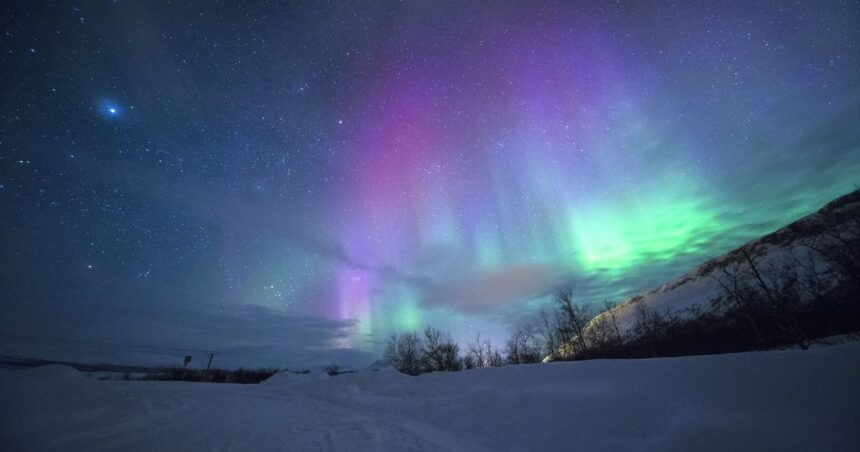A strong geomagnetic storm is expected to hit Earth tonight, and it could create one of the most spectacular auroras we’ve seen in years. This event is due to a powerful solar flare that erupted from the sun a few days ago. The National Oceanic and Atmospheric Administration (NOAA) has issued a geomagnetic storm warning, predicting that the northern lights, also known as the aurora borealis, could be visible much farther south than usual.
What Causes the Aurora?
The aurora is a natural light display that occurs in the polar regions. It happens when charged particles from the sun collide with gases in Earth’s atmosphere. These collisions release energy in the form of light, creating beautiful, colorful displays in the sky. In the Northern Hemisphere, one may witness the aurora borealis, and in the Southern Hemisphere, the aurora australis.
Tonight’s aurora could be particularly special because of the strength of the geomagnetic storm. The storm is classified as a G3, which is considered strong. This means that the aurora could be visible much farther south than usual. People in the northern United States, Canada, and even parts of Europe might be able to see the lights. If you’re in a place with clear skies and little light pollution, you have a good chance of witnessing this amazing event.
How to See the Aurora
To see the aurora, you’ll need to find a dark place away from city lights. Look towards the northern horizon. The best time to see the lights is usually around midnight, but they can appear anytime after sunset. Allow your eyes some time to acclimatise to the darkness with patience. If you’re lucky, you’ll see the sky light up with beautiful colors like green, pink, and purple.
The aurora can appear as a faint glow or as bright, dancing lights. Sometimes, it looks like curtains of light waving in the sky. Other times, it can look like rays shooting up from the horizon. The colors can change and move, creating a mesmerizing display. Each aurora is unique, so you never know exactly what you’ll see.
Why This Aurora Is Happening
This aurora is happening because of a solar flare that erupted from the sun on October 1, 2024. The flare sent a large amount of charged particles towards Earth. When these particles reach our planet, they interact with Earth’s magnetic field, creating a geomagnetic storm. This storm is what causes the aurora to appear.
While the aurora is beautiful to watch, it’s important to stay safe. If you’re going out to see the lights, dress warmly. The nights can be cold, especially in northern regions. Bring a blanket or a chair to sit on, and maybe some hot drinks to keep warm. Also, be careful if you’re driving to a dark location. Make sure to park safely and watch out for other people who might be doing the same thing.
The Science Behind the Aurora
The science behind the aurora is fascinating. The sun constantly generates a stream of charged particles known as the solar wind. When these particles reach Earth, they are usually deflected by our planet’s magnetic field. However, during a solar flare, a large number of particles are sent towards Earth at once. These particles can penetrate Earth’s magnetic field and collide with gases in the atmosphere. These collisions release energy in the form of light, which we see as the aurora.
Auroras have been observed for thousands of years. They have been mentioned in ancient texts and have inspired many myths and legends. In some cultures, the aurora was believed to be the spirits of ancestors dancing in the sky. In others, it was seen as a sign of good fortune or a warning of impending danger. Today, we understand the science behind the aurora, but it still holds a special place in our hearts and imaginations.
Editor’s Recommendations
- Don’t Miss It! Comet from 80,000 Years Ago Lights Up Indian Skies
- Solar Flare X9.0 Alert: Powerful Burst from Sun Could Impact Earth!
- Annular Solar Eclipse on Oct. 2, Witness the Sky’s Fiery Ring at Breakneck Speed
- Once-in-a-Lifetime Event: Corona Borealis Constellation Shine Brighter as Nova Explosion





